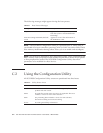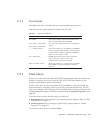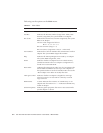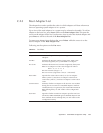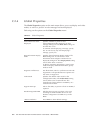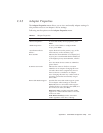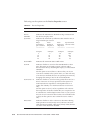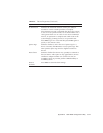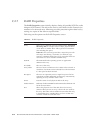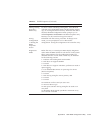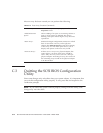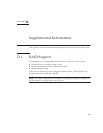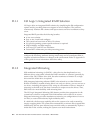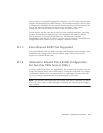
C-10 Sun Fire V20z and Sun Fire V40z Servers—User Guide • March 2005
Following are the options on the Device Properties screen.
TABLE C-8 Device Properties
Option Description
SCSI ID Indicates the device’s SCSI Identifier.
Device
Identifier
Indicates the ASCII device identifier string extracted from
the device’s Inquiry Data.
Sync Rate Indicates the maximum synchronous data transfer rate, in
mega transfers per second.
Mega Data Data Synchronous
Transfers Width=8 Width=16 Period nsec
per Second Mbytes/s Mbytes/s
---------- -------- --------- ----------
0=Async 0=Async 0=Async 0=Async
5 5 10 200
10 10 20 100
20 20 40 50
40 40 80 25
Data Width Indicates the maximum data width in bits.
Scan ID Indicates whether to scan for this SCSI identifier at boot
time. This item can be used to ignore a device and to
decrease boot time by disabling the inquiry of unused SCSI
identifiers.
Set this option to No if there is a device that you do not
want to be available to the system. Also, on a bus with only
a few devices attached, the user can speed up boot time by
changing this setting to No for all unused SCSI IDs.
Scan LUNs > 0 Indicates whether to scan for LUNs greater than zero for a
device. LUN zero is always queried. Use this option if a
multi-LUN device responds to unoccupied LUNs or to
reduce the visibility of a multi-LUN device to LUN zero
only.
Set this option to No if you have problems with a device
that responds to all LUNs whether they are occupied or not.
If a SCSI device with multiple LUNs exists on your system
but you do not want all of those LUNs to be available to the
system, set this option to No to limit the scan to LUN 0
only.
Disconnect Indicates whether to allow a device to disconnect during
SCSI operations. Some (mostly newer) devices run faster
with disconnect enabled, while some (mostly older) devices
run faster with disconnect disabled.



